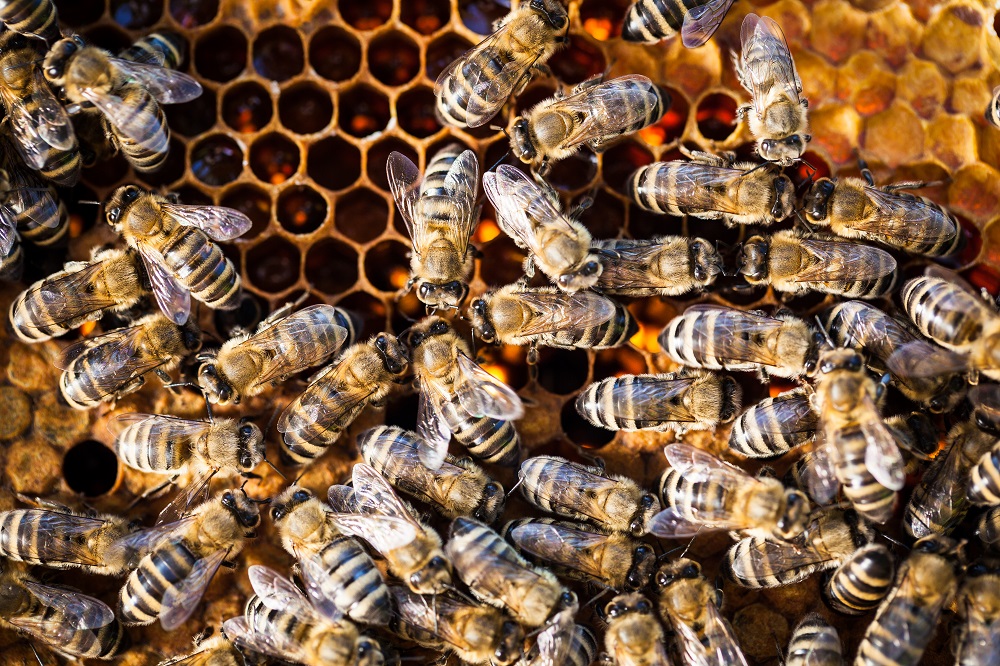Bees
Bees belong to the Hymenoptera order of insects, and are pollinators, feeding on nectar and pollen. Most bee species are solitary and only around 10% live in a social structure, as for example the European honeybee Apis mellifera. This is the most common bee species in the world and, as its name suggests, it produces honey as its food store. Bee colonies have a fascinating social organisation.
The organisation of work in the hive
Honey-bee colonies comprise three distinct castes: the queen, the female workers and the male drones. The queen lays eggs to maintain the entire colony’s descendance; the female workers fulfil the functions necessary for the colony’s development and survival; the males, known as drones, perform the essential task of fertilising the queens. The species has survived for millions of years thanks to swarming, a process of dividing the colony into two populations. A swarm of tens of thousands of workers engorged with honey forms around the queen and flies off, leaving the nest in the original hive, with the nascent brood, around one third of the worker bees and queen cells on the point of hatching. After a merciless combat between the royal pretenders, the victorious young queen replaces her elder and the reformed colony begins to develop.
Bees and the production of honey
Foraging bees are the oldest in the colony. They head out in search of sweet substances: nectar (a watery solution produced by flowers) and honeydew (a sticky substance secreted by sucking insects as they feed on plants). These sweet products are then transformed into honey, the hive’s food reserve. The foraging bees transfer their harvest to young worker bees to enrich it with enzymes, causing some sugars to divide and others to bond together. When ripe, honey can contain over twenty different sugars, with fructose and glucose topping the list. Other workers are responsible for dehydrating the nectar/enzyme solution. They do this by regurgitating it several times, drop by drop, using their tongues to spread it out in a thin layer in the dry hive. They then deposit the honey in the wax cells that form the honeycomb. Fanning bees beat their wings to circulate air. By doing this, they bring the outside air into the colony so it will heat to over 30°C to dry out the honey. When a cell is full and the honey contains less than 18% water, the bees seal it with a wax cap.
Products of the hive
The bees and the queen feed on pollen and royal jelly respectively, but these products can also be harvested for commercial sale. The bees secrete beeswax, and use it with propolis, a resinous substance they gather mainly from tree buds, to build and seal the comb. Stradivarius and other violinmakers used propolis as a lacquer for their instruments. Humans have been using beeswax to make candles and harvesting honey from wild honeybee nests for thousands of years. Beekeeping (or apiculture) only began in Antiquity and honeybees are now kept in fabricated hives on all continents. To harvest the honey, a beekeeper removes the wax caps and places the frames in an extractor, which spins them thereby removing the honey by centrifugal force.
A threatened species?
During their 30 million years of existence, bees have had to contend with countless changes in climate and have survived numerous diseases and pests. Today, however, the disappearance of bees on an unprecedented scale is a particularly worrying phenomenon. Not only are numbers of wild bees in decline, the death of whole hives of domestic bees is an increasingly common occurrence. This is referred to as colony collapse disorder. Scientific research is trying to determine the causes. The Varroa destructor, a parasitic mite native to Asia, infests colonies and poses a serious threat. The heavy use of certain pesticides in agriculture also seems to be playing a role in this phenomenon. Some research is also pointing the finger at mobile telephone waves.
CLEMENT Henri (dir), 2002. Le traîté rustica de l’apiculture. Edition Rustica, Paris
LEHNER Matthias (dir), 2003.l’apiculture-une fascination. Edition VDRB, Winikon
CHARRIÈRE, Jean-Daniel, 2009. Ampleur des pertes de colonies d’abeilles et analyse des facteurs potentiels. Station de recherche Agroscope Liebefeld-Posieux ALP [online]. 31.03.2009. [Accessed on 18.04. 2016]. Available on:
http://horizons.myhostpoint.ch/index4052-2.html?id=1570
HOOD, Mike, 2018, Colony collapse disorder, Encyclopædia Britannica, 20.11.2018, Available on: https://www.britannica.com/science/colony-collapse-disorder
CUCURACHI, Stefano, TAMIS, Wil LM, VIJVER, Martina G., et al. A review of the ecological effects of radiofrequency electromagnetic fields (RF-EMF). Environment international, 2013, vol. 51, p. 116-140. Available on: https://www.sciencedirect.com/science/article/pii/S0160412012002334#bb0595



